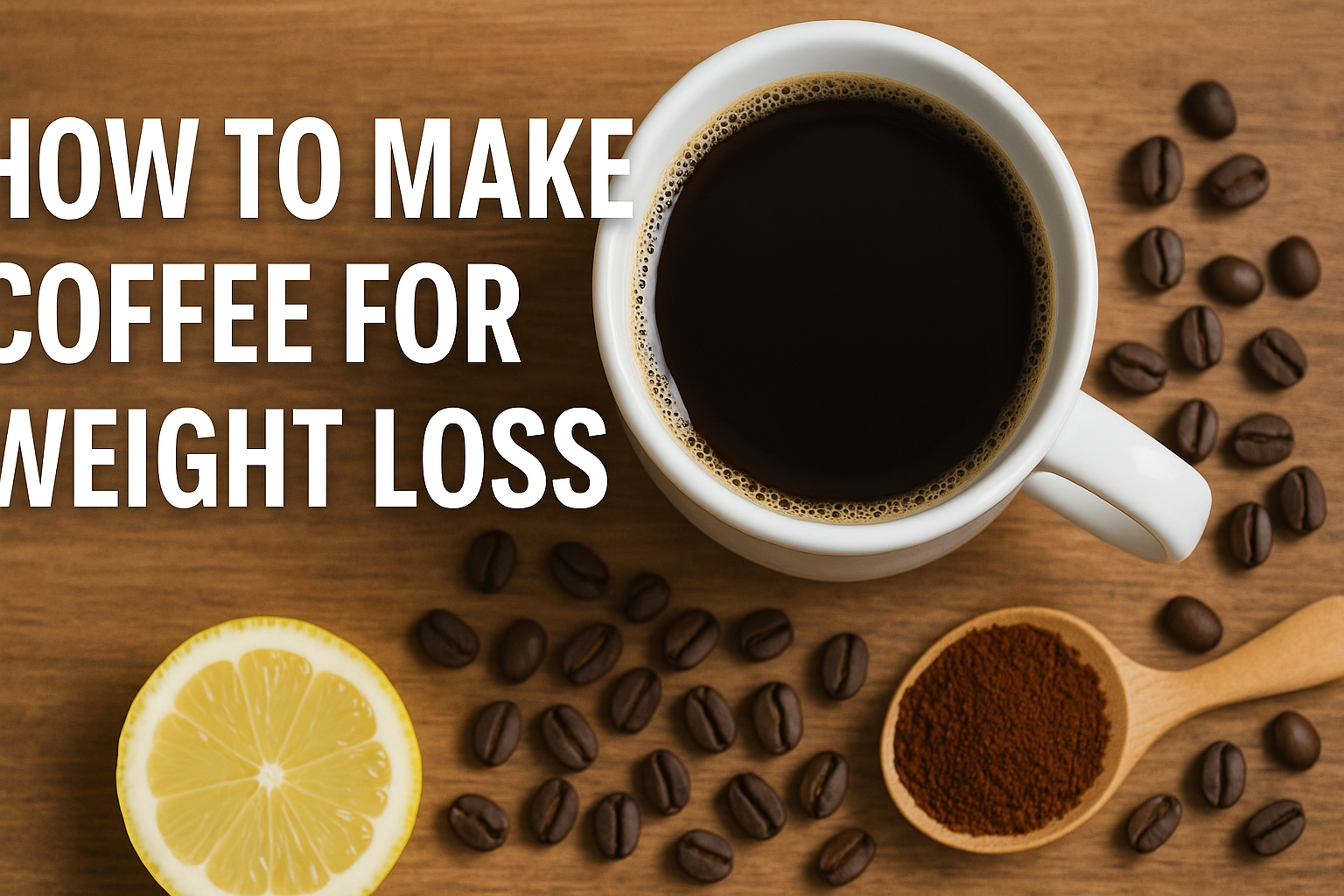Introduction
For millions of people, coffee is more than just a drink—it’s a ritual. That first sip in the morning wakes you up, sharpens your focus, and sets the tone for the day. But what if that same cup could do more than energize you? What if it could help you lose weight?
Research suggests that coffee, when made the right way, may support fat burning, appetite control, and overall metabolism. The problem is that most people unintentionally turn their coffee into a calorie bomb by adding sugar, flavored syrups, or heavy cream. If weight loss is your goal, learning how to brew a healthier cup is essential.
In this guide, we’ll cover the science of coffee and weight loss, the best brewing methods, smart add-ins, mistakes to avoid, and recipes designed to keep your coffee delicious while also supporting your fitness journey.
Why Coffee Can Support Weight Loss
Caffeine as a Metabolic Booster
Caffeine is one of the most researched natural stimulants. It can raise your resting metabolic rate, meaning your body burns more calories even when you’re not moving. Studies show this effect can increase calorie burning by 3–11% for several hours after drinking coffee.
Natural Appetite Suppression
Some people find that coffee dulls their appetite, making it easier to stick to a calorie deficit. Drinking a cup between meals may help reduce unnecessary snacking.
Improved Exercise Performance
Caffeine increases adrenaline levels, which enhances endurance and strength during workouts. That translates into more calories burned and better fat utilization during physical activity.
Antioxidant Benefits
Coffee is packed with antioxidants that fight inflammation and oxidative stress—both of which can slow down metabolism and weight loss.
Picking the Right Coffee
Your choice of beans and brewing style can make a difference.
- Organic beans: Avoid pesticides and chemicals.
- Light to medium roast: Retain more antioxidants compared to very dark roasts.
- Freshly ground: Grinding beans before brewing preserves flavor and nutrients.
- Quality over quantity: One good cup of coffee is better than multiple cups of low-grade blends.
Best Brewing Methods for a Slimmer Cup
1. Black Drip Coffee (Classic Choice)
Simple and calorie-free, black coffee made with a drip machine or pour-over is a solid choice. It delivers caffeine and antioxidants without any extras.
2. French Press
A French press produces a richer, fuller-bodied coffee since the oils aren’t filtered out. This method is great if you prefer a bolder taste.
3. Cold Brew
Cold brew is brewed slowly over 12–24 hours, producing a smoother flavor with lower acidity. It’s refreshing and easy to drink without sugar or cream.
4. Espresso Shots
A concentrated caffeine kick in just one or two ounces, espresso is perfect if you need energy without volume.
Healthy Add-Ins That Can Boost Weight Loss
Not all add-ins are bad. A few natural ingredients can actually enhance coffee’s fat-burning effects.
- Cinnamon: Helps regulate blood sugar and adds sweetness without calories.
- Lemon juice: A squeeze of lemon may aid digestion and hydration.
- MCT oil or coconut oil: Provides healthy fats that promote satiety and energy.
- Unsweetened almond or oat milk: Low-calorie alternatives to dairy creamers.
- Protein powder: Turns coffee into a high-protein breakfast or post-workout drink.
What You Should Avoid
If weight loss is your goal, the wrong add-ins can sabotage progress.
- Sugar and flavored syrups: These add empty calories and spike blood sugar.
- Whipped cream and heavy cream: High in fat and unnecessary calories.
- Artificial creamers: Often contain sugar, oils, and additives.
- Overconsumption: Too much caffeine can cause jitters, disrupt sleep, and lead to cravings.
Coffee Recipes for Weight Loss
1. Straight Black Coffee
- Brew with fresh ground beans using drip, French press, or pour-over.
- Drink plain, hot, or iced.
- Zero calories, pure caffeine boost.
2. Lemon Coffee
- Brew one cup of black coffee.
- Stir in a teaspoon of lemon juice.
- This refreshing combo supports digestion and hydration.
3. Bulletproof Coffee
- Blend 1 cup of black coffee with 1 tablespoon MCT oil and 1 teaspoon grass-fed butter.
- Creates a creamy, filling drink that can replace breakfast.
4. Green Coffee
- Brew with unroasted green coffee beans.
- Rich in chlorogenic acid, which may reduce carb absorption and support fat loss.
5. Protein Coffee (“Proffee”)
- Brew hot or iced coffee.
- Mix with a scoop of protein powder (vanilla or chocolate).
- Ideal for post-workout recovery.
When to Drink Coffee for Maximum Impact
Timing matters just as much as preparation.
- Morning: Kickstarts your metabolism after waking.
- Before workouts: 30–60 minutes prior enhances energy and fat burning.
- Between meals: Can reduce hunger and prevent overeating.
Avoid coffee late in the evening, as disrupted sleep can counteract weight loss efforts.
Risks and Things to Keep in Mind
Coffee isn’t a miracle weight-loss solution. Here are some caveats:
- Acidity issues: Drinking coffee on an empty stomach may upset digestion for some people.
- Sleep disruption: Too much caffeine can affect sleep, slowing fat loss.
- Dependence: Relying too heavily on coffee for appetite suppression isn’t sustainable.
- Individual tolerance: Everyone metabolizes caffeine differently.
FAQs
Q: How many cups of coffee per day are safe for weight loss?
A: 2–3 cups (200–300 mg of caffeine) is considered safe for most adults.
Q: Can I sweeten my coffee and still lose weight?
A: Use natural, low-calorie options like stevia or monk fruit instead of sugar.
Q: Does adding milk ruin weight-loss coffee?
A: Not necessarily—just keep portions small and stick to low-calorie options.
Q: Is bulletproof coffee good for everyone?
A: It works well for some people on low-carb diets, but it’s high in calories, so it should replace a meal, not add to your intake.
Final Thoughts
Coffee can absolutely be a helpful ally in your weight-loss journey—if you brew it the right way. Stick to black coffee or recipes with natural, healthy add-ins. Avoid sugar, heavy cream, and calorie-dense extras that turn your cup into dessert.
Use coffee strategically: drink it in the morning, before workouts, or between meals to maximize its fat-burning and appetite-suppressing effects. Remember, though, that coffee is a tool, not a magic fix. Sustainable weight loss comes from combining smart nutrition, regular exercise, and good sleep habits.
So tomorrow morning, when you reach for your coffee mug, think of it not just as a wake-up call—but as part of your plan to reach your health goals.

